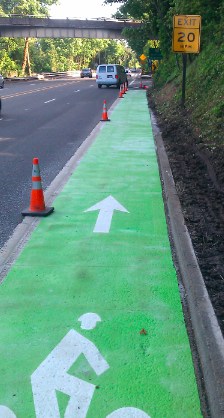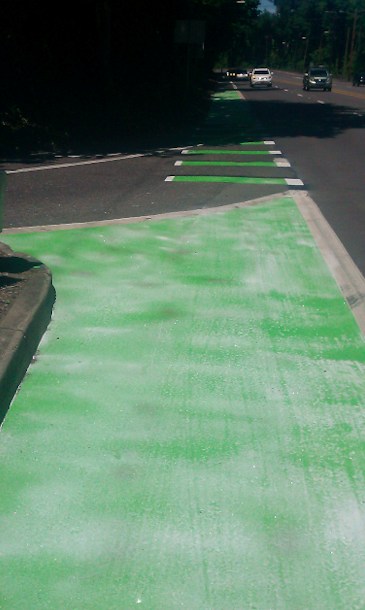
(Photo: Alan Love)
I’ve got a couple of news tidbits from the Oregon Department of Transportation (ODOT) that have piled up in my inbox so I thought I’d share them all at once. From a new job opening in their Active Transportation section to the installation of their first-ever green colored bikeway, the agency continues to show positive progress.
First, according to a reader who rides on SW Barbur everday, the Oregon Department of Transportation has just completed the main part of their Barbur Blvd Bike Improvement Project (a project we shared more about back in March). Reader Alan Love reports that ODOT has added green coloring the southbound bike lane on Barbur Blvd. that leads to the Beaverton-Hillsdale Highway turnoff.
Here are two photos of the new markings sent in by Alan…


Speaking of ODOT’s active transportation priorities; the agency has just posted a major job opening titled, Operations and Policy Analyst 3 (Transit & Active Transportation Liaison). The description calls for someone to, “lead ODOT’s participation in all transit, bike and pedestrian project development and coordination activities within Region 1” (Region 1 is Portland’s region.) The person will also, “Research innovative options for active transportation projects, and help refine projects to better meet ODOT and partner needs” and “Manage research, analysis or projects related to ODOT’s role in Active Transportation in the Portland Metropolitan Region.”
To my knowledge, this is a new position that hasn’t existed in the past. This is likely to be an important cog in the wheel at ODOT and whoever gets the position will be poised to have real influence over how the agency moves forward in biking, walking, and transit. Please spread word of this position and have all of your smartest friends apply.
And finally today, I want to share a comment from ODOT Director Matt Garrett. As you might recall, I recently reported on a proposal from ODOT’s Motor Carrier Division that would have given freight interests overwhelming power in Oregon. As part of my research for that story, I asked Garrett a few questions via email. He didn’t respond quickly enough to be in my story; but I wanted to share one of his responses I just received.
I asked Garrett if his decision to suspend new guidelines for the implementation of ORS 366.215, and begin a “collaborative” new rule-making process for it, was related to his efforts to build a better active transportation network in Oregon. Here’s how he answered:
“Yes, I would say that it is related, in part, to ODOT’s commitment to active transportation, but there are many factors at play. ODOT is committed to both helping communities create and maintain active transportation networks, and preserving the ability of trucks to move on our highways. To achieve these goals ODOT is committed to trying to resolve potential conflicts between freight and active transportation.
A driver in creating ODOT’s new Active Transportation section was to integrate programs and funding sources to support the selection and delivery of projects that are multidimensional transportation projects, providing complete transportation solutions for communities. The ORS 366.215 discussion is a great example of how the transportation system is a complex, multi-modal transportation system with inherit conflicts. ODOT is in a unique position in that it operates state highway system in which national and international companies rely to move goods as part of their day-to-day operations. At the same time, ODOT has an obligation to all users of the larger transportation system – bike, pedestrian and transit – to provide safety and reliability. For example, I like to buy apples at the Sellwood New Seasons [Garrett lives at SE 42nd and Flavel]. In terms of transportation, this raises many questions: How does my apple get from the orchards in Hood River to New Seasons? Does Oregon’s freight network allow for enough mobility to truck the apple in a timely manner so its still fresh when it arrives at the store? Does it do so in a way that doesn’t compromise the needs of the local system? Will that truck that delivers the apples be on the same road as the sidewalk that I use to walk to the store? Does that truck route and my pedestrian route overlap near the store? You can see where I am going with this. There are inherent conflicts in the system, and one of ODOT’s roles to to balance many factors and come up with the best solutions possible.”
I realize Garrett tends to be somewhat verbose; but when you consider where ODOT is coming from and the bureaucratic constraints he’s operating under, it seems he’s sincerely trying to change the agency for the better (his unabashed support for the Columbia River Crossing notwithstanding). To continue on this path, to do more projects like the one on SW Barbur, and to fight off forces from within his own agency to maintain the auto and truck-centric status quo, Garrett will need all the pro-bike/transit/walking staffers he can muster.


